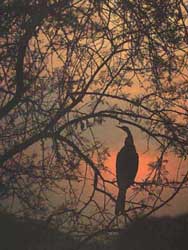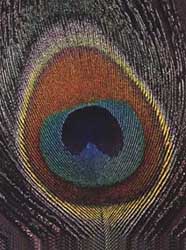| Environment The Peacock's Last Dance
|
|||||
"The peacock made a complaint to Juno that, while the nightingale pleased every ear with his song, he himself no sooner opened his mouth than he became a laughing-stock to all who heard him. The Goddess, to console him, said, "But you far excel in beauty and in size. The splendour of the emerald shines in your neck and you unfold a tail gorgeous with painted plumage." "But for what purpose have I," said the bird, "this dumb beauty so long as I am surpassed in song?' "The lot of each," replied Juno, "has been assigned by the will of the Fates - to thee, beauty; to the eagle, strength; to the nightingale, song; to the raven, favourable, and to the crow, unfavorable auguries. These are all contented with the endowments allotted to them." - Aesop's Fables: The Peacock and Juno. Translated by George Fyler Townsend. |
Environment
Wildlife | ||||
Writes Valmik Thapar in his book, Land of the Tiger, "In ancient India, its wheel-like tail was a symbol of the all-seeing sun and all eternal cosmic cycles, but it also represents rebirth, the heavens and the stars and the unity of the cosmos. Again, these beliefs are not confined to Hinduism - the peacock plays an important role in the Muslim story of creation." Widely found in the Indian sub-continent from the Himalayas to Sri Lanka, it is our national bird, a position that has not necessarily helped secure its future. Its status as the vahan of Subramanya or Kartikeya, son of Lord Shiva and its role in Hindu mythology has offered it some immunity over the years. But unfortunately this is fast changing. Today, its population is under threat due to habitat destruction, poaching and contamination of its food sources. Peacocks are in demand for their beautiful feathers and even for their fat, which is erroneously believed to be useful in the treatment of arthritis. Primarily poached for its feathers that are sold openly in India and abroad, peacock populations are plummeting across India. In June 2002, the customs department in Chennai seized about 46 kg. of peacock feathers, 173 kg. of sea cucumber and 650 kg. of snakeskin at the cargo complex. Peacock feathers are sold openly in Ooty and other tourist destinations. Incidents of locals poisoning waterholes to kill peacocks and deer for their meat in protected areas such as Melghat have also been reported. More and more peacocks are being killed in villages that once venerated the birds.
The bird is protected under Section 51, 1-A of the Wildlife Protection Act, 1972 and killing it is strictly prohibited. The export of peacock tail feathers, articles and handicrafts made there from, has been banned under the Convention on International Trade in Endangered Species and the export-import policy of India. There is a blanket ban on the export of birds from India, yet the illegal trade continues. Live peacocks are still being smuggled. Their feathers are used to make costumes and fans. The Indian peacock is bred in captivity in USA. Thousands are sold each year as pets and also for medicinal use. The legs and claws of the bird are boiled to extract 'anti-arthritic oil'. According to Maneka Gandhi, "When the original Act was made, it was believed that trade in peacock feathers could be allowed because the peacock sheds its feathers but the peacock does not shed its feathers enough for a trade to continue. There is no doubt that the peacock is trapped, killed and then its feathers are plucked out and sent to the shops and trading centres. If it becomes difficult, then mass poisoning takes place." The role of peacocks and other birds in the food chain is crucial. They are important biological control agents. By feeding on insects and controlling weeds, they increase the nitrogen content of the soil. There is little awareness among people that using peacock feathers means that a peacock has been killed in the process of procuring that feather. Snake charmers and madaris bringing bears and monkeys to dance in our cities and towns abuse these animals. When we patronise them or visit circuses or buy birds as pets, we encourage poaching. Let us not abuse nature's bounty by misusing it. Peacocks and vultures are dying from pesticide use today; tomorrow it could be us. The threads we unravel today may ensnare us tomorrow.
Courtesy: Sanctuary Magazine
|
|||||
Editor: Romola Butalia (c) India Travelogue. All rights reserved. |
|||||
 The peacock may not be content with its "dumb beauty" but humans have always been enamoured by this familiar and spectacular member of the pheasant family. A beautiful ocellated train, a shimmering blue breast and the long, slender neck of the male Pavo cristatus make it a spectacular bird. The female is a sober mottled-brown with some metallic green on the lower neck but lacks the train. The peacock is called 'the bird with one hundred eyes' due to the eye-like patterns in its tail. It is believed to be a harbinger of the approaching monsoon, with its elaborate courtship dance seen all over the country before the rains. Many associate this spectacular bird with fertility and good luck.
The peacock may not be content with its "dumb beauty" but humans have always been enamoured by this familiar and spectacular member of the pheasant family. A beautiful ocellated train, a shimmering blue breast and the long, slender neck of the male Pavo cristatus make it a spectacular bird. The female is a sober mottled-brown with some metallic green on the lower neck but lacks the train. The peacock is called 'the bird with one hundred eyes' due to the eye-like patterns in its tail. It is believed to be a harbinger of the approaching monsoon, with its elaborate courtship dance seen all over the country before the rains. Many associate this spectacular bird with fertility and good luck.
 The most shocking was the death of around 40 peacocks in Morena in Madhya Pradesh - a place that derives its name from Mor (peacock) and has a sizeable peacock population. The post-mortem reports in most of these cases revealed the consumption of insecticide-washed seeds from nearby fields. According to Earth Island Journal, "The peacock, India's national bird, may be on the brink of extinction. Farmers use pesticides such as chloropyriphos and endosulfan to battle termites. After munching seeds treated with these insecticides, male peacocks have been seen falling from trees, unable to fly."
The most shocking was the death of around 40 peacocks in Morena in Madhya Pradesh - a place that derives its name from Mor (peacock) and has a sizeable peacock population. The post-mortem reports in most of these cases revealed the consumption of insecticide-washed seeds from nearby fields. According to Earth Island Journal, "The peacock, India's national bird, may be on the brink of extinction. Farmers use pesticides such as chloropyriphos and endosulfan to battle termites. After munching seeds treated with these insecticides, male peacocks have been seen falling from trees, unable to fly."